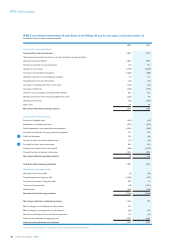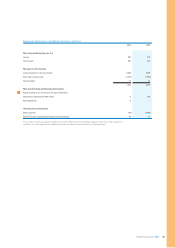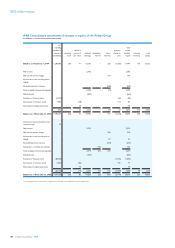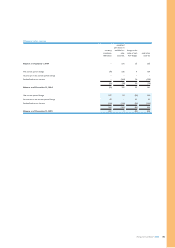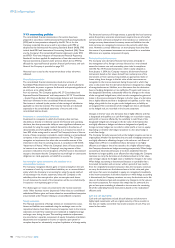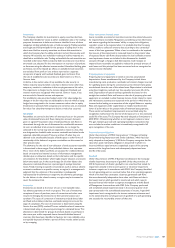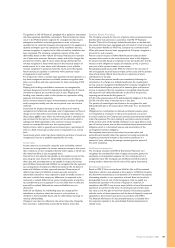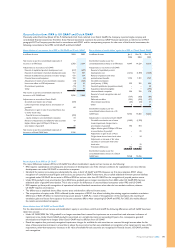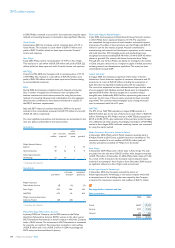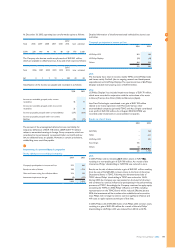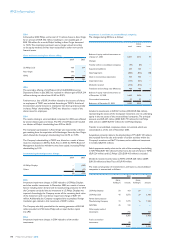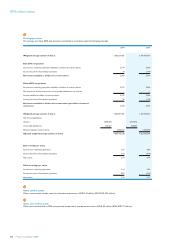Philips 2005 Annual Report Download - page 190
Download and view the complete annual report
Please find page 190 of the 2005 Philips annual report below. You can navigate through the pages in the report by either clicking on the pages listed below, or by using the keyword search tool below to find specific information within the annual report.Philips Annual Report 2005190
Cashowstatements
Cashowstatementshavebeenpreparedusingtheindirectmethod
in accordance with the requirements of IAS 7 ‘Cash Flow Statements’.
Cashowsinforeigncurrencieshavebeentranslatedintoeurosusing
the weighted average rates of exchange for the periods involved.
Cashowsfromderivativeinstrumentsthatareaccountedforasfair
valuehedgesorcashowhedgesareclassiedinthesamecategory
asthecashowsfromthehedgeditems.Cashowsfromderivative
instruments for which hedge accounting has been discontinued are
classiedconsistentwiththenatureoftheinstrumentasfromthe
date of discontinuance.
Use of estimates
Thepreparationofnancialstatementsrequiresmanagementtomake
estimates and assumptions that affect amounts reported in the consolidated
nancialstatementsinordertoconformtogenerallyacceptedaccounting
principles. Actual results could differ from those estimates.
Application of IFRS 1
With regard to the options that are offered in IFRS 1 ‘First-time Adoption
of International Financial Reporting Standards’ the Company has chosen
to use the options that are offered by IFRS 1 as described below.
ForemployeebenetsunderIAS19‘EmployeeBenets’theCompany
has chosen to recognize all cumulative actuarial gains and losses at
January 1, 2004. In accordance with IFRS 1 such recognition has
occurred directly in equity.
The cumulative translation differences related to foreign entities
within equity are deemed to be zero at January 1, 2004. Accordingly,
these cumulative translation differences were included in retained
earnings in the IFRS opening balance sheet. This also will have the
effect that upon disposal of a foreign entity only cumulative translation
differences that arose after January 1, 2004 can be recognized in the
result upon disposal.
Business combinations that were recognized before January 1, 2004
will not be restated to IAS 22/IFRS 3 ‘Business Combinations’.
Share-based payment transactions that were granted on or before
November 7, 2002 are recognized in accordance with the
requirements of standard IFRS 2 ‘Share-based payments’, which is
effective as from that date. Consequently, the Company applies the
exemption as offered by IRFS 1 to apply IFRS 2 to all share-based
payment grants that had not vested as at the date of transition to IFRS.
•
•
•
•
New IFRS accounting standards
The IASB and its interpretation committee IFRIC issued several
pronouncements during 2005, of which the following are applicable to
the Company.
In April 2005 the IASB issued an amendment to IAS 39 under the
heading “Cash Flow Hedge Accounting of Forecast Intragroup
Transactions”. The amendment allows hedge accounting for highly
probableforecastintragrouptransactionsinconsolidatednancial
statements. The Company adopted this amendment and applied the early
application provision to all periods presented. The effect of application
ofthisamendmenttotheIFRSnancialstatementsisnotmaterial.
In August 2005 the IASB issued the new Standard IFRS 7 ‘Financial
Instruments’: Disclosures. The standard requires disclosure of the
signicanceofnancialinstrumentsforanentity’spositionand
performance, and qualitative and quantitative information on risks arising
fromnancialinstruments.TheStandardbecomeseffectivefrom2007
onwards. The effect on the Company’s disclosure is expected to be
limited because many of the required disclosures are already supplied.
In September 2005 the IASB’s interpretation committee IFRIC issued
Interpretation6‘LiabilitiesarisingfromParticipatinginaSpecicMarket
– Waste Electrical and Electronic Equipment’. This Interpretation concerns
the recognition of liabilities resulting from the European Union’s
Directive on Waste Electrical and Electronic Equipment (WEEE), which
came into effect on February 13, 2003. Member States were required
to transform the Directive into national law by August 13, 2004. Under
this Directive, costs of disposing of electrical and electronic equipment
used by households in an environmentally acceptable manner are borne
by producers. The Directive stipulates that the producers of that type of
equipmentwhoareinthemarketinaperiodspeciedintheapplicable
nationallegislation(themeasurementperiod)mustnancecostsrelated
to waste management for equipment that was sold to private households
before August 13, 2005, the so-called historical waste. For other waste,
such as related to equipment sold after August 13, 2005 (future waste)
or equipment sold to others than households, the Directive provides
thatproducersareresponsiblefornancingwastemanagementcosts.
The Directive allows the Member States to allow producers to charge
theircustomersavisiblefeefornancingwastemanagement.
IFRIC Interpretation 6 is solely related to historical waste and has
mandated that no liability shall arise for historical waste held by
private households other than for waste costs for equipment in the
measurement period.
The Company is a provider of equipment that falls under the EU
Directive, particularly in the segments Lighting, Consumer Electronics,
Domestic Appliances and Personal Care, and Medical Systems. As at the
endof2005,anumberofstatesincludingsignicantEUMemberStates
did not yet have their national legislation in place. Accordingly, the
Company was not able to reliably estimate all effects of the WEEE
Directive with respect to future waste. In as far as the historical waste is
concerned, which is covered by Interpretation 6, the Company concluded
that the effects on the income statement are not material as at the end
of 2005. This is mainly caused by the fact that the costs are compensated
by fees charged to the customers. Also for the coming years the effects
are estimated to be limited on the assumption that all Member States
will allow visible fees to be charged to the customers. With respect to
future waste, however, the effects may become material over time, as
we will have to reserve for waste management costs for all products
that fall under the Directive and that were or will be sold after the
dates of enactment in local laws of the EU Member States. Over the
next years when products will be returned and disposed, the estimated
cost of future waste management is expected to increase as a function
of the expected life of the products and return rates. These expected
costs will be charged to the income statement and a provision will be
made in the balance sheet in as far amounts can be reliably estimated
andrepresentexpectedoutowsofassetsfortheCompany.
IFRS information




